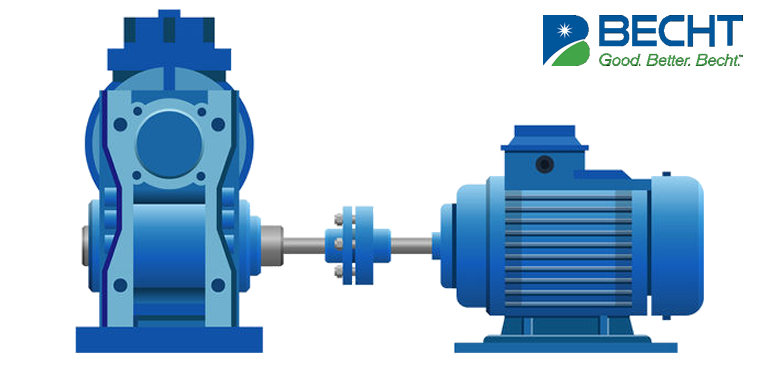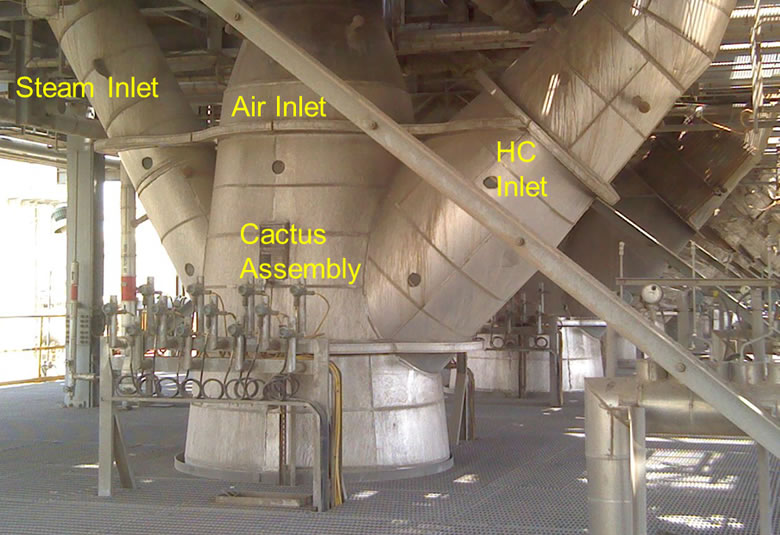Very Unusual Motor Vibration Issue Resolved with Innovative Vibration Analysis & Solution
Background and The Problem
24 new 3600 RPM, 440 volt AC induction motors were replaced at a large refinery as a result of flooding during hurricane Ike. The motors were inundated by 6 ft to 12 ft of floodwater. The new motors were from three of the major industrial motor manufacturers. Horsepower ratings ranged from 40 hp to 100 hp. After the motors were installed, they were checked for soft foot and aligned to the driven equipment. They were then connected electrically and soloed with couplings removed so that vibration data could be collected to insure they met specification. All of the motors had excessive 2X line frequency (7200 cpm) vibration amplitudes ranging from 0.2 ips-pk to 0.6 ips-pk. For each of the 24 motors, when one or more of the motor feet were released, the 2X vibration dropped to 0.08 ips-pk or below. When re-tightened, the vibration immediately returned. All soft foot readings were below 0.002 in.
The most likely cause of this uncommon problem was thought to be flood induced changes in the equipment’s “pile and cap” foundations. The very economical solution to the problem derived from sophisticated vibration analysis saved the client the significant cost of replacing or repairing these foundations.
Testing and Analysis
To solve this problem the first issue addressed was to check that the motor frame / feet were sufficiently robust to accept the small amount of soft foot experienced without distorting the frame and stator. It was thought that there might be enough distortion to affect the concentricity of the stator, resulting in excessive 2X line frequency (7200 cpm). The motors were removed and a number of the foundations were field machined. About half of the motors were sent to an outside shop to map the feet to insure they were flat and co-planer. When returned to the plant and reinstalled, the same vibration levels returned when the motors were again soloed. Since the majority of the motors (~15) were from a single manufacturer, they were contacted regarding the problem. They agreed to promptly send two new motors to a local shop for testing. We sent the two worst motors that had been installed so they could be tested as well. Data was collected with an eight channel analyzer with the motors bolted to a flat rigid test bed. All overall vibration readings were below 0.08 ips and amplitudes at 2X line frequency (7200 cpm) were below 0.04 ips on all motors. A 5 mil soft foot condition was then introduced by installing a 5 mil shim under three of the motor feet, leaving the fourth foot 5 mils high. All four feet were bolted down again. Vibration readings were again recorded with no change in amplitudes. Next, the 5 mil shim diagonal from the soft foot above was removed. This resulted in two diagonal feet having 5 mil soft foot. Vibration readings were again recorded with no perceptible change.
A final test was performed by placing a 10 mil shim under two diagonally opposed feet resulting in the two remaining feet being 10 mil soft. Each of the four motors was run in this configuration and vibration data recorded. In all cases there was no perceptible change in vibration, particularly at 7200 cpm. This proved that all of the motors had frames sufficiently rigid to prevent 2X line frequency (7200 cpm) vibrations due to stator deformation even with 10 mil soft feet being introduced at 2 diagonal feet.
Two of the motors were reinstalled at the plant so that 4 Frequency Response Measurements (FRF) measurements could be collected on the motors, base plates and foundations. It was discovered that when reinstalled, both installations experienced natural frequencies within 5% of 7200 cpm. The extremely low levels (0.04 ips-pk) of vibration at 7200 cpm generated by the motor were exciting the system natural frequency and causing the
large vibration responses.
Next, the operating deflection shape was measured on two motor installations. Vertical motions on the motor, base plate and foundation were very low. Horizontal readings in all locations were excessive with the highest readings at the top of the motor. Horizontal readings decreased towards the bottom of the foundation. Amplitudes at 3600 rpm were less than 0.08 ips. The predominant frequency was still 2X line frequency or 7200 cpm. Amplitudes at the top of the motor were 0.6 ips-pk. When the model was animated using a software application, there were no nodes identified. All measured points were moving horizontal in phase with each other with the largest motion at the top. When the amplitudes were plotted against elevation, a straight line resulted (no curl). Several attempts to brace the installation in the horizontal direction were attempted with no success.
Review of some history regarding the site the plant was built on revealed that in many of the areas, individual or groups of pump foundations were built on concrete “caps” supported by pilings. Below the concrete paving, sand may have been used to backfill. Since the facility is located in relative proximity to a river, the storm surge experienced as well as 12 feet of flood water may have displaced some of the fill material. If this happened, the horizontal stiffness of the structure could have been reduced. This could have allowed a natural frequency well above 7200 cpm to shift downward and be excited by the small energy levels generated by the motors at 7200 cpm. Another contributing factor was the fact
that the replacement premium efficiency motors weighed ~20% more than the motors which were replaced. Once again, adding mass and reducing stiffness would act to lower the frequency of any natural frequency which existed above 7200 cpm.
Unique and Innovative “FIX”
In the early stages of this problem, soft foot and angular soft foot was suspected to be a possible cause of the excessive vibration. Precision brand Sof Shoe Shims were suggested as a possible mitigation step. They come in 2 thicknesses and are installed above and below the stainless steel shim pack. They compensate for angularity between the equipment foot and the foundation surface. The manufacturer claims that a single 0.045 in. shim will compress to 0.040 in. and no more. These shims were installed on several motors. When soloed again, vibrations at 2X line frequency (7200cpm) were greatly reduced. In one case the amplitude at 7200 cpm dropped from 0.6 ips-pk to 0.04 ips-pk. In another case, the 7200 cpm amplitude dropped from 0.4 ips-pk to 0.06 ips-pk. Since the shop tests mentioned earlier demonstrated the motors could withstand soft foot conditions, further testing was performed to determine just how the Sof shims were interacting with the motor, base plate system. FRF measurements were again made on the subject motors with and without the Sof shims installed. It was found that one of the thicker shims (0.045″) on either side of the stainless shim pack had a dramatic effect. In one application the natural frequency was measured at 7380 cpm on hard shims and 4320 cpm on the yellow Sof shoe shims. In another application, the natural frequency was measured at 6780 cpm on hard shims and 5220 cpm on the Sof shoe shims. On the two applications mentioned, the % critical damping was calculated to be 0.06 and 0.04.
It was suspected that the shim material had very low stiffness properties in shear. This would account for the reduction in system natural frequency when the shims were added. The shim manufacturer was contacted to determine if material properties were available which could explain the reduction in natural frequency. No shear properties were available. A test fixture was fabricated that would clamp two yellow shims between two 0.750 in. plates bolted together. A jack bolt was then used to displace the top plate while recording the torque used to do so. A dial indicator was used to record the displacement of the top plate for a given force. The two shims had a combined stiffness in shear of about 201 lb/mil. As stated above, in one test the natural frequency had been reduced from 7380 cpm to 4320 cpm by adding the two yellow shims. Dynamic stiffness testing showed the original stiffness in the horizontal to be about 385 lb/ mil. The addition of the two yellow soft shims resulted in the addition of a spring in series with a stiffness of 201 lb/mil. The combined stiffness of the two springs in series resulted in a system stiffness of 132 lb/ mil. This resulted in lowering the natural frequency away from the 2X line frequency (7200 cpm) vibrations produced by the motors.
All of the 24 motors are now mounted on “Sof Shoe” shims and are running with acceptable vibrations.
At that point, no further investigation was planned to determine what changes, if any, may have occurred regarding support and stiffness of the pilings and caps under the foundations.
[readon2 url=”index.php?option=com_rsform&view=rsform&formId=4&Itemid=620″]Click to Request Info[/readon2]






